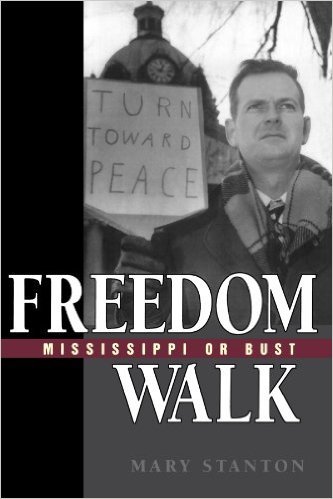- Freedom Walk – Mississippi or Bust
- by Mary Stanton
- University Press of Mississippi
- Copyright 2003
- 208 pages
Rating – 7/10

Summary – Freedom Walk tells the stories of two dreamers – Bill Moore and Sam Shirah, Jr. Both attempted a protest march during the civil rights movement. Neither man succeeded and their stories are largely forgotten. Freedom Walk is good and holds the reader’s attention. However, author Mary Stanton misses some opportunities and that will frustrate her readers.
Review – In April 1963, an eccentric postal worker named Bill Moore announced that he was going to walk from Chattanooga, Tennessee, to Jackson, Mississippi. His walk was a protest against segregation. Moore never made it. He was shot to death near Attala, Alabama, on the third day of his walk. A grand jury declined to indict the alleged shooter. Freedom Walk’s first hundred pages focus on Moore.
After Moore’s death, other civil rights workers vowed to finish his walk. The second half of the book discusses their attempts and – unfortunately – strays much farther afield. Stanton includes the life story of Sam Shirah, Jr. – an Alabama-born son of a Methodist minister who was one of the marchers who tried to finish what Moore started.
The Shirah material is not bad. He was an interesting person, the rare southern white who had the nerve to speak in favor of civil rights. However, the shift from Moore’s story to Shirah’s isn’t entirely successful. The reader feels as though he or she accidently changed channels in the middle of a TV show.
What Might Have Been
At the very end of the book, author Mary Stanton recounts her attempt to retrace some of Moore’s steps in 2000. Floyd Simpson, the man who allegedly shot Moore, had died in 1998; however, when Simpson met Moore on the day of Moore’s death, he’d been with a friend named Gaddis Killian. Moore, Simpson, and Killian had a charged conversation a few hours before Moore’s murder.
In 2000, Stanton pulled up to Killian’s junk shop and talked to him about nothing in particular. Then, losing her nerve, she drove away without even mentioning Moore’s death. For the reader, it’s a huge letdown. To be blunt, Stanton’s unwillingness to ask a single question about Moore amounts to malpractice.
What’s Left
If the reader wants to look at the glass as half full, there’s a lot of good in Freedom Walk. A recurring theme is that most of the white volunteers in the civil rights struggle came from society’s fringe. If the white activists weren’t on the fringes when they started, they soon ended up there.
Moore fits into that mold. He was a dreamer who always needed somewhere to put his energy. The civil rights and disarmament movements provided him with outlets. Other aspects of his life were less successful. He spent years in a New York mental hospital and was living apart from his wife and stepchildren at the time of his death.
The reader is more ambivalent about Stanton’s portrait of Shirah. It takes you a while to comprehend the abrupt turn that the narrative takes when Stanton shifts from Moore to Shirah. Once you wrap your mind around the shift, the material is interesting, but not wholly compelling.
Shirah was a lot like Moore, a dreamer in search of a cause, who happened to come along at the time of the civil rights movement. The ties between the two men are ever so slight – they tried to complete the same, quixotic march. Predictably, Shirah’s life after the civil rights movement was nowhere near as compelling as what came before.
Footnotes in “The Movement”
Unfortunately, it seems as though the world may “little note nor long remember” Moore or Shirah. Neither was a Martin Luther King. But both played interesting parts in one of the most-important social movements in the past hundred years. Their stories are worth remembering and Stanton does a good job of ensuring that both receive a measure of our acclaim.
Advertisements Like this:Like Loading... Related




